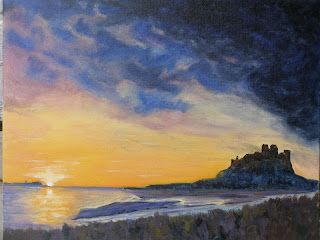Brushes in hand and easel at the ready, along with a litany of advice, tips and things to think about I headed out into the wide world and produced my next oils en plein air. Again a mixture of aspects that I found pleasing and things that were little short of embarrassing. The first image is my first attempt at limiting my palette - raw sienna, burnt sienna, paynes grey and white and I almost succeeded in the self discipline until the very final stage when I cheated a little with a touch of cad yellow to warm some of the green. The limited palette approach is advocated in many of the books that I've been reading and certainly makes you think. I resolved to adopt a version of this approach in an attempt to develop my sensitivity to colours and their production on the canvas.
 Little stream
Little stream - Plein Air Oil Sketch, canvas board 12" x 10"
Another trip out along the coast to a well known landmark, the St. Mary's Island Lighthouse resulted in the next painting. As my friends in Wet Canvas tell me I don't pick easy subjects and there are distinct signs of my lack of mastery in all of these images, but there are also signs of heeding some of the lessons picked up along the way. Complex scenes like this, with conditions changing as the incoming tide alters the scene before you, make it difficult to be accurate in drawing and I will return to this site and select a viewpoint that will ease some of those problems and hopefully improve the perspective.
 St. Mary's Island
St. Mary's Island - Plein Air Oil Sketch, canvas board 12" x 10"
Even though splashing oil was becoming my disease, the watercolour kit usually accompanies me on trips out. A last visit of the year to the Lake District gave me the opportunity to produce a painting of one of our favourite watering holes.
 The Swan at Grasmere
The Swan at Grasmere - Watercolour 14" x 10"
Various other exercises filled my other painting hours and the painting below is taken from a photograph that I had taken on a holiday in the US during the previous year.
 Yellowstone
Yellowstone - Oil, canvas board 12" x 10"
All of the outings and exercises were building up experience and posting the paintings on Wet Canvas began to get me both encouragement and invaluable advice. I would put that advice to use in attempting a larger piece of work. It was also about time for me to spend some time in front of some real art and I began planning a number of visits to see the best that the country has to offer in the wonderful galleries that are scattered around. They will be the subject of my next post.
















 A weary walk to the hotel and dinner punctuated by a continuous parade of mental images inspired by the day's viewing.
A weary walk to the hotel and dinner punctuated by a continuous parade of mental images inspired by the day's viewing.









 Pen and watercolour sketch
Pen and watercolour sketch